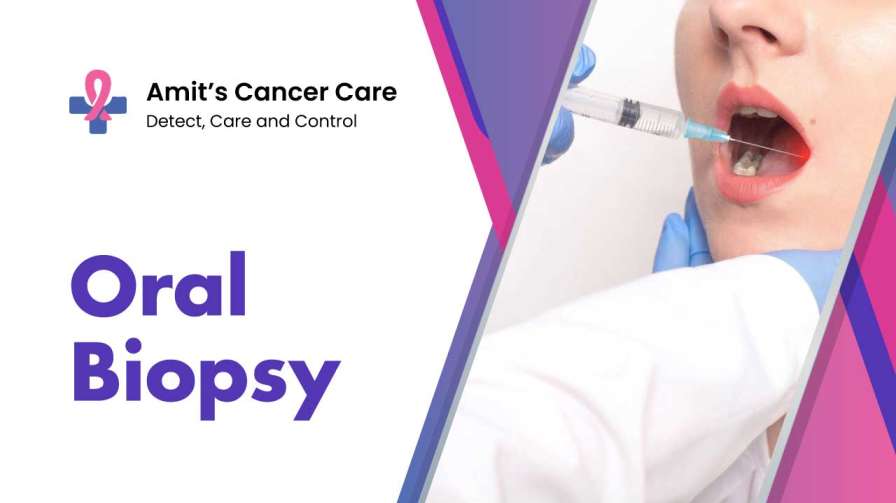
How to perform oral-biopsy?
Oral biopsies are vital in diagnosing and treating various oral conditions, including cancer, precancerous lesions, and other abnormalities.
This procedure involves the removal of a small tissue sample from the oral cavity, which is then examined under a microscope to identify any potentially concerning or abnormal cells.
Let’s understand the steps in performing an oral biopsy, emphasizing the importance of accuracy, patient comfort, and adherence to ethical standards.
We will discuss the necessary preparations, the techniques utilized during the procedure, and best practices for ensuring optimal patient outcomes.
By following these guidelines, one can ensure that oral biopsies are conducted safely and effectively, leading to timely diagnoses and facilitating appropriate treatment planning.
So, let’s dive into the details and explore the essential elements of performing an oral biopsy with precision and care.
What are Oral Biopsies?
An oral biopsy is a medical procedure performed on a small tissue sample from the mouth for diagnostic purposes. It involves investigating and diagnosing various oral, such as suspicious lesions, ulcers, growths, or other abnormalities.
As doctors, we perform oral biopsies to determine the presence of cancerous or precancerous cells, infections, or other oral diseases.
Preparing for the Procedure
Before proceeding with an oral biopsy, evaluating the patient and obtaining their informed consent is crucial Patient’s medical history, medications, and any allergies that may affect the procedure.
Additionally, consider performing necessary pre-operative tests to ensure the patient’s safety and well-being.
To prepare the patient for the biopsy, instruct them to fast for a specific period before the procedure, depending on the type of biopsy planned.
Inform the patient about the procedure’s purpose, benefits, and potential risks. Answer any questions they may have to alleviate their concerns and ensure their comfort throughout the process.
Gathering the Necessary Tools and Equipment
To perform an oral biopsy, several essential tools and instruments are required. These include biopsy forceps, local anaesthesia, sterile gauze, suture materials, and sterilisation equipment.
Ensure that all instruments and tools are readily available and adequately sterilised to maintain aseptic conditions during the procedure.
Administering Anesthesia
Pain management is a crucial aspect of performing an oral biopsy. To minimise discomfort, administer local anaesthesia to the biopsy site before proceeding.
Carefully choose an appropriate anaesthetic agent, considering any allergies or sensitivities the patient may have. Administer the anaesthesia according to established protocols and guidelines.
Related Read: Is mouth cancer curable?
Performing the Oral Biopsy
Performing an oral biopsy requires precision and careful technique. Here is a step-by-step guide to carrying out the procedure:
Locating the Lesion or Abnormal Area: Identify the suspicious lesion or abnormal area in the patient’s mouth using visual inspection and palpation.
Grasping the Tissue Sample: Use biopsy forceps to grasp a small piece of the tissue from the identified area. Be gentle to minimize trauma.
Removing the Tissue Safely: Ensure the tissue sample is removed without causing excessive bleeding or damage to surrounding structures. Use appropriate techniques based on the type of biopsy, such as incisional, excisional, or punch biopsy.
Handling and Preparing the Biopsy Specimen
After obtaining the tissue sample, handle it carefully to preserve its integrity and ensure accurate laboratory analysis. Follow these guidelines:
Proper Labeling and Documentation: Label the specimen container accurately and include relevant patient information, such as name, date, and biopsy site. Fill out any required documentation or requisition forms.
Communication with the Laboratory: Communicate with the laboratory where the specimen will be sent for analysis. Follow their specific requirements for packaging, transporting, and processing the biopsy sample.
Preserving Tissue Integrity: Store the biopsy specimen appropriately, considering the tissue type and the laboratory’s instructions. Ensure the specimen is kept at the required temperature and protected from physical damage.
Post-Procedure Care and Follow-Up
After the biopsy, provide the patient with clear instructions for post-procedure care. Emphasize the importance of following these guidelines to promote healing and minimize complications. Discuss the following aspects:
Oral Hygiene: Instruct the patient on proper oral hygiene, including gentle brushing, rinsing with salt water, and avoiding irritating substances.
Dietary Restrictions: Advise the patient to avoid hot, spicy, or acidic foods that may irritate the biopsy site. Encourage a soft or liquid diet if necessary.
Follow-Up Appointments: Schedule a follow-up appointment to discuss the biopsy results with the patient. This allows for further evaluation and appropriate treatment planning if necessary.
You might also want to Read: Treatment Options for Mouth Cancer
Ensuring Safety and Minimizing Risks
While performing an oral biopsy, it is essential to prioritize patient safety and minimize potential risks. Consider the following measures:
Infection Control: Adhere to strict infection control measures throughout the procedure. Maintain a sterile environment and use disposable instruments whenever possible.
Aseptic Technique: Follow proper aseptic techniques, such as wearing sterile gloves, using sterile gauze, and properly cleaning and disinfecting the biopsy site.
Patient Comfort: Prioritize patient comfort throughout the procedure. Communicate with the patient, address their concerns, and ensure their pain is effectively managed with local anesthesia.
Proper Training and Expertise: Ensure that the oncologist performing the oral biopsy is adequately trained and experienced in the procedure. This helps minimize potential complications and ensures accurate tissue sampling.
Adherence to Ethical and Legal Standards: Maintain strict adherence to ethical and legal standards when performing an oral biopsy. Respect patient autonomy, privacy, and confidentiality at all times.
Conclusion
An oral biopsy requires precision, careful technique, and a patient-centered approach. By following the step-by-step guide outlined in this article, oral cancer surgeons in Mumbai can ensure accurate tissue sampling, timely diagnosis, and effective treatment planning. Remember to prioritize patient comfort, safety, and well-being throughout the process.
